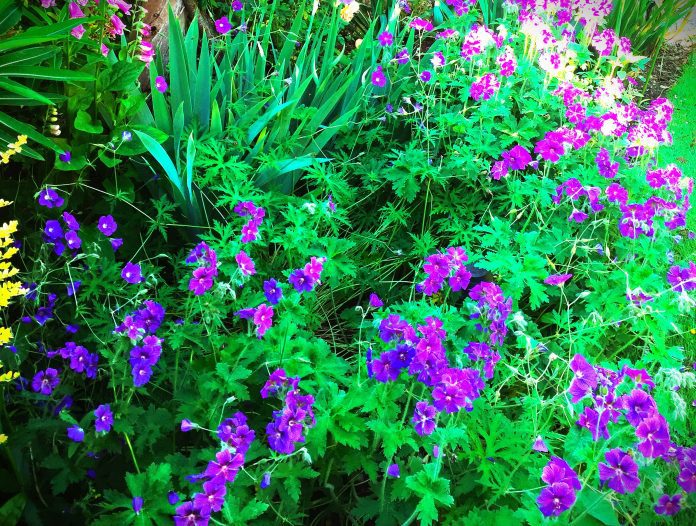Perennial geraniums, or true geraniums (Geranium spp.), are hardy, long-lasting plants that bring color, structure, and texture to any garden. Known for their low-growing habit and dainty, five-petaled blooms, these geraniums are ideal for filling borders, adding ground cover, and creating naturalistic landscapes. They bloom profusely from spring through summer, and their foliage often provides additional seasonal interest by changing color in autumn.
Growing Perennial Geraniums
Perennial geraniums are loved for their adaptability and tolerance of various garden conditions. They’re low-maintenance, pest-resistant, and suitable for a wide range of climates.
Location and Soil Requirements
Perennial geraniums thrive in a mix of sun and partial shade, though some varieties can tolerate more shade, making them versatile for different garden spots. They prefer well-drained soil rich in organic matter, but they’re adaptable and can tolerate slightly poorer soils as long as there is good drainage.
Planting Perennial Geraniums
Plant geraniums in early spring or autumn for the best results. Space them approximately 12 to 18 inches apart, depending on the variety, to give them room to grow and spread. Their low, mounded growth makes them perfect for mass plantings, edging, and border fronts. Once planted, water them regularly to establish strong root systems, especially during their first growing season.
Watering and Fertilizing
Perennial geraniums are relatively drought-tolerant once established, needing moderate water. They perform best in evenly moist soil but can endure short periods of drought. An annual application of compost or a slow-release fertilizer in spring will provide the nutrients needed to support their growth and flowering, though many varieties thrive with minimal feeding.
Pruning and Maintenance
Deadhead flowers as they fade to prolong blooming, and prune back the foliage after flowering to encourage fresh, dense growth and possible re-blooming in late summer. In autumn, perennial geraniums may be cut back to the ground after foliage has faded, or you can leave the foliage for winter interest and cut back in early spring.
Pests and Diseases
Perennial geraniums are resistant to most pests and diseases, making them a great low-maintenance choice. Occasional issues with aphids or mildew can be managed with natural insecticides or improved airflow around the plants. Deer and rabbits tend to leave geraniums alone due to their slightly scented foliage.
Best Perennial Geranium Varieties
Here are some of the best-loved types of hardy geraniums for the garden:
Geranium Rozanne
A popular choice, Geranium Rozanne has violet-blue flowers with white centers and blooms from late spring to frost. It has a spreading habit, making it an excellent choice for ground cover or flowing borders. Rozanne can reach 2 feet in height and 3 feet in spread.
Geranium Johnson’s Blue
Known for its intense blue flowers, Johnson’s Blue blooms in late spring to early summer and forms dense mounds of foliage. Growing to about 18 inches in height, this variety works beautifully in borders or rock gardens.
Geranium macrorrhizum (Bigroot Geranium)
A versatile and tough variety, Bigroot Geranium is known for its fragrant foliage and pink or magenta blooms in late spring. It’s particularly shade-tolerant and has leaves that turn red in the fall, adding multi-season interest.
Geranium pratense (Meadow Cranesbill)
With soft, finely cut leaves and violet-blue blooms, Meadow Cranesbill thrives in sunny areas and tolerates a variety of soil conditions. It’s a bit taller, reaching up to 3 feet, and looks fantastic in cottage gardens.
Geranium sanguineum (Bloody Cranesbill)
This low-growing variety has dark pink to crimson flowers and blooms profusely in early summer. It’s especially hardy, with foliage that turns deep red in autumn, hence its name “Bloody Cranesbill.” It’s ideal for rock gardens, borders, or filling in gaps.
Geranium cinereum (Ashy Cranesbill)
Perfect for rock gardens or the front of borders, Ashy Cranesbill has delicate, silvery leaves and compact pink, purple, or white flowers. It’s drought-tolerant once established and thrives in sunny, well-drained sites.
Using Perennial Geraniums in the Garden
Perennial geraniums bring a naturalistic, informal charm to the garden. They’re wonderful for softening the edges of paths, underplanting roses, and pairing with perennials like lavender, salvia, and ornamental grasses. Their low, spreading habit makes them ideal for ground cover or planting in drifts to create a meadow-like effect. Hardy geraniums are also popular choices for shade gardens, where varieties like Geranium macrorrhizum add lush foliage and color to shady spots under trees.
Final Thoughts
With their ease of care, adaptability, and beautiful blooms, perennial geraniums are a valuable addition to any garden. Whether you’re looking for ground cover, border plants, or colorful fillers for shaded areas, there’s a perennial geranium suited to your needs. Select varieties based on bloom time, color, and growth habit, and enjoy the enduring charm these plants bring year after year.




